- Document type
- Round-up
- Published
- 07 March 2006
Midnight Eye Round-Up
Anime special
By Jasper Sharp
- Tragedy of Belladonna
- Taro the Dragon Boy
- Dagger of Kamui
- Patlabor 1: Mobile Police
- My Neighbours the Yamadas
Tragedy of Belladonna
- Original title:
- Kanashimi no Beradonna
- Director:
- Eiichi YAMAMOTO
- Cast:
- Chinatsu NAKAYAMA, Aiko NAGAYAMA, Tatsuya NAKADAI, Takao ITO, Masaya TAKAHASHI
- Running time:
- 89 mins.
- Year:
- 1973
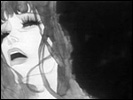 By the beginning of the 70s, Osamu Tezuka's Mushi Pro company were pushing for a new form of expression within the theatrical animated feature, beginning with One Thousand and One Arabian Nights (1969) and Cleopatra (1970). Aimed at an adult audience, the films introduced an overt erotic content to the production company's increasingly eclectic design style.
By the beginning of the 70s, Osamu Tezuka's Mushi Pro company were pushing for a new form of expression within the theatrical animated feature, beginning with One Thousand and One Arabian Nights (1969) and Cleopatra (1970). Aimed at an adult audience, the films introduced an overt erotic content to the production company's increasingly eclectic design style.
For Belladonna, the third and final of this Animerama series, Tezuka dropped completely out of the picture, having resigned as company president in 1971 to focus more on his manga work, giving long-term animation associate Eiichi Yamamoto, who had directed a number of Mushi Pro's works such as the TV-series Kimba the White Lion (1965), much greater reign as a director. Released as an art movie, sadly Belladonna failed to find an audience at the time of its release, and Mushi Pro went bankrupt in 1973.
Based on the 1862 novel La Sorcière by Jules Michelet, Belladonna pushes the aesthetic of its predecessors into an entirely new realm, paying due homage to modernist and Art Nouveau painters like Gustav Klimt, Odilon Redon, Alphonse Mucha, Egon Schiele and Felicien Rops within its luscious design style, with art design by celebrated illustrator Kuni Fukai.
For the most part barely animated, this tale of Joan of Arc being drawn from the path of god by an intentionally phallic-looking devil (voiced by Nakadai) unfolds in a series of fin de siècle tinged static tableau in its depiction of a feudal society ruled by superstition and religious persecution. These static sequences, narrated by Chinatsu Nakayama, make way for a number of highly imaginative psychedelic interludes packing an undeniable erotic charge, as images of its curvaceous muse, long-lashed eyes framed by a torrent of swirling hair, morph into sensuous swelling abstractions of bulging forms and curving lines, with the whole movie laid down to a funky prog rock soundtrack that makes heavy use of the Hammond organ sound. The result is a boldly unique work, very much of its era, whose nearest point of reference are the trippy Gerald Scarfe-designed animated sequences of Alan Parker's Pink Floyd: The Wall (1982).
[JS]
Taro the Dragon Boy
- Original title:
- Tatsu no Ko Taro
- Director:
- Kirio URAYAMA
- Cast:
- Junya KATO, Miina TOMINAGA, Kazuo KUMAKURA, Kazuo KITAMURA, Kirin KIKI, Sayuri YOSHINAGA
- Running Time:
- 75 mins.
- Year of Release:
- 1979
- DVD:
- Discotek Media (US, English subtitles/dub)
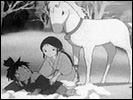 Sitting roughly halfway along a timeline bridging The Little Norse Prince and Spirited Away, Taro the Dragon Boy sees Toei turning to native source material in a magical blend of myth and fantasy that is sure to inflame the imaginations of kids from elementary age upwards of whatever culture. Set in the mountainous and mysterious Shinshu Province, where in days of yore the locals eked out a harsh mountainside existence of the type depicted in Shohei Imamura's The Ballad of Narayama (1983), and based on an oral legend set in print by Miyoko Matsutani in 1962, it follows the adventures of Taro (Kato), a lazy and gluttonous whelp who spends his days loafing around in bed and filling his face with rice-balls while the grandmother who has raised him breaks her back toiling the paddies with the rest of the hungry villagers.
Sitting roughly halfway along a timeline bridging The Little Norse Prince and Spirited Away, Taro the Dragon Boy sees Toei turning to native source material in a magical blend of myth and fantasy that is sure to inflame the imaginations of kids from elementary age upwards of whatever culture. Set in the mountainous and mysterious Shinshu Province, where in days of yore the locals eked out a harsh mountainside existence of the type depicted in Shohei Imamura's The Ballad of Narayama (1983), and based on an oral legend set in print by Miyoko Matsutani in 1962, it follows the adventures of Taro (Kato), a lazy and gluttonous whelp who spends his days loafing around in bed and filling his face with rice-balls while the grandmother who has raised him breaks her back toiling the paddies with the rest of the hungry villagers.
The mysterious circumstances surrounding his birth see Taro taunted by the other local kids. After his father was killed by a rockslide before he was born, his mother Tatsuyo (Yoshinaga) was forced to earn her keep working in the mountains while pregnant. One day, during a storm, she disappeared, and Taro arrived in the village floating down the river in a basket, sucking on a ball of milk that was once his mother's eyeball. Legend has it that his mother was transformed by a curse into a giant white dragon, and now sightless, has relocated to the depths of a lake far to the north of the country.
One day, while Taro is idling away his waking hours wrestling with his forest animal friends (like Kintaro, another figure from Japanese folklore whose exploits have often found their natural home in animation), a long-nosed, puce-faced tengu (goblin) appears and offers him a swig of saké. His skin taking on a pink blush, Taro is filled with an unnatural strength. He first puts his new powers to good use fending off the Red Demon, or oni (Kumakura), which goes berserk with jealous rage when a mysterious girl named Aya arrives in the woodland, charming the animals with her melodious flute playing. The defeat of the Red Demon marks Taro's emergence into the world of adulthood, earning him a loincloth in the process (quite a relief after all the cartwheels and headstands he does in the early stages of the film while wearing nothing beneath his short tunic!), but before long he has an even mightier foe to tackle, when the vanquished Red Demon hands over Aya to his larger neighbour the Black Demon (Kitamura), who has a healthy appetite for the delectable young maidens bought up to the mountaintop by the villagers to appease him.
Soft, rounded character designs characterise this production as one pitched towards the younger viewer, but the film's most eye-catching aspect is the mystical flat inky-black backgrounds over which the tale unfolds, which evoke traditional sumi-e wash paintings and lend further atmosphere to Taro's later encounters with a ghastly witch in a secluded mountain cabin and a trio of spectral snow women (yuki-onna) during a blizzard as he embarks on his quest to free his mother from her curse. It might come as some surprise to learn that the main body of director Urayama's work lies outside of animation. He began his career at Nikkatsu as an assistant director and scriptwriter (in the late 50s he co-scripted Yuzo Kawashima's The Sun Legend of the End of the Tokugawa Era / Bakumatsu Taiyoden and Seijun Suzuki's Harbour Toast: Victory is in our Grasp / Minato no Kanpai: Shori o Wagate ni), making his debut as a director in 1962 with The Street with Cupolas (co-written with Shohei Imamura).
Released in the US in dubbed form on video in 1984, Taro the Dragon Boy has lain forgotten in the West ever since, making this new Diskotek release a particularly welcome one. The DVD presents the English language soundtrack alongside the original Japanese, making the simply wonderful film an unforgettable and inspirational entry point for pre-teens into the colourful world of Japanese animation.
[JS]
Dagger of Kamui
- Original title:
- Kamui no Ken
- Director:
- RINTARO
- Cast:
- Hiroyuki SANADA, Mami KOYAMA, Yuriko YAMAMOTO, Kaneto SHIOZAWA, Kentaro ISHIDA, Ichiro NAGAI, Shoko IKEDA, Michio HAZAMA
- Running time:
- 132 mins.
- Year:
- 1985
- DVD:
- AnimEigo (US, Eng subtitles/lang)
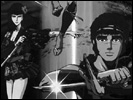 During the dying days of the Tokugawa Era, the clash between those loyal to the shogun's rule and the insurgent Satsuma Clan threatens to crush all those caught in the middle. When his adoptive parents are slain by a shadowy group of ninjas, the finger of suspicion immediately points towards Jiro (Sanada), a foundling discovered floating down the river in a basket with nothing more than a note from his real mother and an ornate dagger. After the young adolescent is hounded from his home at Sai village, he is picked up by the monk Tenkai (Ishida), under whose charge he is trained as a shinobi (ninja). But this early encounter soon turns out to be something of a mixed blessing, when it becomes clear that it did not occur by chance.
During the dying days of the Tokugawa Era, the clash between those loyal to the shogun's rule and the insurgent Satsuma Clan threatens to crush all those caught in the middle. When his adoptive parents are slain by a shadowy group of ninjas, the finger of suspicion immediately points towards Jiro (Sanada), a foundling discovered floating down the river in a basket with nothing more than a note from his real mother and an ornate dagger. After the young adolescent is hounded from his home at Sai village, he is picked up by the monk Tenkai (Ishida), under whose charge he is trained as a shinobi (ninja). But this early encounter soon turns out to be something of a mixed blessing, when it becomes clear that it did not occur by chance.
Following his training, Jiro's quest to trace his lineage takes him first to Ezo (latter-day Hokkaido), where he learns how his real mother, an Ainu named Oyaruru (Ikeda) sent him floating off in a basket following the disappearance of his Japanese father, Taroza (Hazama). A renegade ninja eager to see the end of the shogun's rule due to their systematic oppression of Ezo's indigenous populations, Taroza's legacy to his infant son was the Dagger of Kamui that accompanied him on his arrival in Sai, with kamui meaning "wind of the gods" in Ainu. The blade has the potential to bestow great power on those whose hands it falls into, but its secret currently remains firmly locked within its sheath.
The first thing one might note about the debut of Rintaro (Space Galaxy 999, Metropolis) is its length. But to be fair, its 132-minute running time comes chock-full with adventure as Jiro embarks on his cross-continental odyssey in search of ancient treasure buried by Captain Kidd, en route picking up a string of multi-ethnic friends and followers including an icily beautiful assassin with a snow-white complexion named Koyuki (whose Louise Brooks-styled bob and general attire is later echoed in Kaizo Hayashi's colourful fantasy Zipang) and an African American slave named Sam, before finding his mirror image in Nevada in the form of Chico, a French girl similarly abandoned at birth and raised by Native Americans whom he saves from the lusty clutches of two rapacious rednecks. There's even a crucial chance encounter with Mark Twain.
The quality of the animation and character designs are strong, with sword blows rendered as luminous jets of light, long snaking vaporous trails, crimson-hued freeze frames, and showers of leaves serving as expressive devices in the heightened moments of action. Such scale is in keeping with the big-is-better approach favoured by Haruki Kadokawa, the movie mogul whose production company was an offshoot of his father's Kadokawa Shoten publishing empire, which published the Toru Yano novel on which the film is based. But like Kenya Boy, the previous year's foray into this market from Kadokawa (also distributed theatrically by Toei), it perhaps suffers from trying to cram a lot of disparate elements into the meandering plot, with one contrivance too many setting the house of cards toppling towards the end.
No doubt some will lament the lack of an English language dub track on the Animeigo DVD release under review. However, it is interesting to note that during the 80s the film was released under the title Blade of Kamui in a US edit that took pains to divorce the visuals from its historical and cultural context.
[JS]
Patlabor 1: Mobile Police
- Original title:
- Kido Keisatsu Patoreba: The Movie
- Alternative title:
- Patlabor: The Movie
- Director:
- Mamoru OSHII
- Cast:
- Toshio FURUKAWA, Miina TOMINAGA, Ryunosuke OBAYASHI, Yoshiko SAKAKIBARA, Yo INOUE
- Running time:
- 98 mins.
- Year:
- 1989
- DVD:
- Manga Entertainment (US/UK, English subtitles/dub)
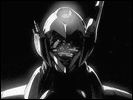 Starting its animated life as a 7-episode, direct-to-video OAV series in 1988, prompting a 47-episode TV series, a second 16-episode OAV series and the first movie version the following year, the world of Patlabor was originally created by a group known as Headgear, which included Mamoru Oshii, Masami Yuki, Kazunori Ito, Yutaka Izubuchi and Akemi Takada among its members. The original manga conceived by Yuki in the early 80s was published simultaneously with the release of the first series. Adding humour and social comment into the mecha mix, Patlabor sits proudly among the role call of the most popular and important cult anime series of its era.
Starting its animated life as a 7-episode, direct-to-video OAV series in 1988, prompting a 47-episode TV series, a second 16-episode OAV series and the first movie version the following year, the world of Patlabor was originally created by a group known as Headgear, which included Mamoru Oshii, Masami Yuki, Kazunori Ito, Yutaka Izubuchi and Akemi Takada among its members. The original manga conceived by Yuki in the early 80s was published simultaneously with the release of the first series. Adding humour and social comment into the mecha mix, Patlabor sits proudly among the role call of the most popular and important cult anime series of its era.
Its stage is an incredibly futuristic-looking Tokyo just before the turn of the 21st century, where rising sea and population levels have prompted mammoth urban redevelopment and the creation of a large manmade island in Tokyo Bay as part of the controversial Babylon Project. The construction is undertaken by giant humanoid robots known as Labors, controlled by the human worker inside them as if they were sitting in a truck cab.
The stories all focus on the members of Special Vehicles Division 2, a law-enforcing unit formed to combat all crime undertaken using the Labor machines. This Mobile Police force is a hideously under-funded body cobbled together to take care of new crimes that emerge from the widespread use of this new technology, and, made up of a colourful selection of techno-geeks and misfits, is an organisation that few in the general public or the world of officialdom take wholly seriously. Rather than the robots that they pilot, it is this diverse and richly defined collection of characters (including Noa, Asuma, Shinobu, Shige, Kanuka and Oda) that form the core appeal for fans, with the focus on the different characters in the group changing with the each story.
In the first movie version, a spate of recent incidents of Labors rampaging out of the control of their operator is tracked down to a fault in their newly installed Hyper Operating System released by Shinohara Heavy Industries. The original programmer Eiichi Hoba spectacularly committed suicide by jumping into the bay. However, his body was never retrieved and all personal information has been scrubbed from his employment records, and neither the Shinohara company nor the government who have invested heavily with public money in the project seem willing to acknowledge the problem. Then the Patlabor team discover that the bug is in fact an act of wilful sabotage by Hoba to impede the ceaseless construction by turning machine against machine and tearing down the city. The bug is triggered by the high-pitched sound of wind whistling through tall buildings, and guess what, there's a typhoon heading straight towards Tokyo.
Aside from being a great series in their own right, the main claim to fame for Patlabor is that it represents a pivotal work for director Oshii and his regular team of composer Kenji Kawai and scriptwriter Kazunori Ito (they also collaborated on the live-action feature Red Spectacles in 1987). The first two Patlabor features saw Oshii moving away from the more action-based nature of the OAV and TV series, though retaining the characterisation and dramatic structure that would be increasingly left behind with the more abstract allegories of his later work.
Though the story stems from Yuki, typical Oshii elements remain - man at the mercy of machinery; mistrust of authority in the form of large, faceless government and corporate agencies; the rapidly changing face of the city; an invisible virus taking control of large machines; computer systems spitting out Biblical texts as they go haywire, and references to dogs (with their ultrasonic hearing). Visually, the detailed designs pursue the same realistic cinematic goals so prevalent in anime from the late 80s onwards, mimicking camera effects such as wide-angle lens shots in several scenes, though like most works from this pre-CGI era, the animation doesn't quite look as impressive as it once did. But though largely devoid of spectacular action sequences, in general this theatrical outing is far more accessible to the casual viewer than Oshii's later works.
Mamoru Oshii directed the more ambitious Patlabor 2: The Movie in between his second live action feature Stray Dog: Kerberos Panzer Cops (Keruberosu: Jigoku no Banken, 1991) and his international breakthrough Ghost in the Shell. WXIII: Patlabor the Movie 3 eventually surfaced in the summer 2002, directed by Takuji Endo with Fumihiko Takayama acting as directing supervisor, with a script adapted by Tori Miki from an original story by Yuki, with Oshii's final contribution to the Patlabor world restricted to writing the three spoof Mini-Pat short animations that accompanied the release of this third feature.
[JS]
My Neighbours the Yamadas
- Original title:
- Ho Hokekyo: Tonari no Yamada-kun
- Director:
- Isao TAKAHATA
- Cast:
- Yukiji ASAOKA, Toru MASUOKA, Masako ARAKI, Hayato ISOHATA, Naomi UNO
- Running time:
- 104 mins.
- Year:
- 1999
- DVD:
- Optimum Asia (UK, English subtitles/dub)
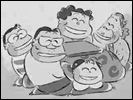 Based on Hisaichi Ishii's popular Asahi Shinbun newspaper cartoon strip, My Neighbours the Yamadas seems like a strangely out-of-character work from Studio Ghibli, certainly viewed against the epic fantasies of Hayao Miyazaki that have only relatively recently appeared on foreign radars. But more the foreman than the hands-on craftsman, the company's co-founder Isao Takahata has tended more to dabble with a variety of different narrative and visual styles rather than push the medium to its fantastical extremes, entrusting the designs and pen-and-ink work to the main animation staff. This has resulted in near misses like the pompous Pompoko, but more often than not produced such undeniable hits as the heart-rending Grave of the Fireflies and probably his best work, the sublime rite-of-passage movie Only Yesterday, which this film occasionally resembles.
Based on Hisaichi Ishii's popular Asahi Shinbun newspaper cartoon strip, My Neighbours the Yamadas seems like a strangely out-of-character work from Studio Ghibli, certainly viewed against the epic fantasies of Hayao Miyazaki that have only relatively recently appeared on foreign radars. But more the foreman than the hands-on craftsman, the company's co-founder Isao Takahata has tended more to dabble with a variety of different narrative and visual styles rather than push the medium to its fantastical extremes, entrusting the designs and pen-and-ink work to the main animation staff. This has resulted in near misses like the pompous Pompoko, but more often than not produced such undeniable hits as the heart-rending Grave of the Fireflies and probably his best work, the sublime rite-of-passage movie Only Yesterday, which this film occasionally resembles.
My Neighbours the Yamadas' slight, skit-based narrative revolves around the titular family of five - gruff father Takeshi (Masuoka), prone to tossing out incomprehensible epithets and life lessons to his uninterested offspring, domestically-inept mother Matsuko (Asaoka), brother and sister Noboru (Isohata) and Nonoko (Uno) and their cantankerous grandma Shige (Araki). It plays like a watered-down version of The Simpsons by way of the American Peanuts strips of Charles Schultz, complete with quotations from the celebrated haiku poet Matsuo Basho to lend it the most delicate of Japanese aromas. Broken up into segments bearing titles such as "Marriage, Yamada Style" and "Father-Son Bonding", its uncomplicatedly humanistic message is that a family that plays together, stays together.
Blessed with a style composed of simple line drawings filled in with subtle watercolour washes of barley white and cornflower blue against only the scantest of background details, Yamadas' deceptively simple complexion belies the fact that the project actually involved some pretty deft behind-the-scenes CG work, which sent its production costs soaring - see if you can see the joins in such masterfully rendered sequences as the dappled shadow effects on the backs of the swarming sharks as the family make their way across the turbulent "oceans of life".
Unfortunately it failed to find much in the way of an appreciative audience upon its initial run in Japan, bringing a momentary dip in the company's unstoppable box office run between the smash successes of Princess Mononoke and Spirited Away, and the film represents something of a white elephant as far as Miyazaki was concerned. Aside from looking after one of the segments of Kihachiro Kawamoto's divine international collaboration A Winter's Day (2003), it saw Takahata's retreat from the Ghibli frontline as a director. Yet, with its quaintly nostalgic but instantly recognisable vignettes of modern Japanese family life, this is a film whose whimsical charms are best appreciated on DVD.
[JS]